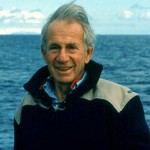Dr. Walter Munk

Dr. Walter Munk
Emeritus, Institute of Geophysics and Planetary Physics, Scripps Institution of Oceanography
His early work on wave predictions in World War II, in collaboration with Harald Sverdrup, led to the first successful Allied offensive of the war in northern Africa (Oran). The predictions were used in the Pacific Theater of War and, ultimately, for the landings in Normandy on D-Day. According to Blair Kinsman (1965: Wind Waves), “There are some thousands of World War II veterans alive today who would have been dead in the surf had Sverdrup and Munk not done the best with what they had.”
Throughout Munk’s career, he has worked closely with the Navy and has the singular honor of holding the Secretary of the Navy Chair in Oceanography for the past 35 years. In the early 50’s he observed the Eniwetak H-bomb test from a lonely 5’ by 5’ raft located about five miles off-shore as part of a tsunami warning system for near-by islands. In the 60’s Walter recorded the progression of waves along six stations positioned on the great-circle route, stretching 6,000 nautical miles from New Zealand to Alaska. The experiment proved that the California summer swell can originate in the Indian Ocean, halfway around the world (to the delight of the surfing community). The Heard Island Feasibility Test of 1993 demonstrated that low-frequency sound pulses could be recorded half-way around the Earth, confirming the use of Ocean Acoustic Tomography as a tool for monitoring global ocean warming.
Walter’s career keeps taking him back to the study of waves; he is currently attempting to learn more about the physics of wind drag on the ocean, a central problem of physical oceanography. He is also focusing on climate change with emphasis on sea level rise.
Among his numerous awards and honors, he has received the National Medal of Science (1985), Kyoto Prize (1999), Prince Albert I Medal (2001), Crafoord Prize (2010), Explorers Medal (2014) and been elected a Member of the National Academy of Science (1956), the American Philosophical Society (1965), the Royal Society of London, Foreign Fellow (1976), and the Russian Academy of Sciences (1994).
